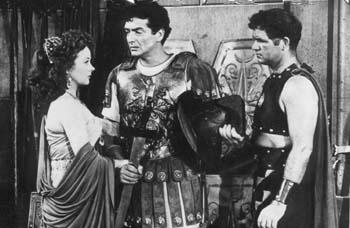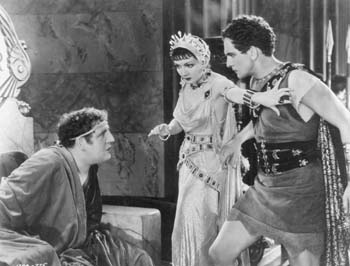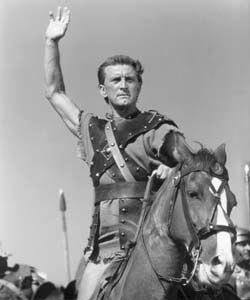![[Metroactive Movies]](/movies/gifs/movies468.gif)
[ Movies Index | Show Times | San Jose | Metroactive Central | Archives ]
Roman Charges
The revival of the gladiator epic says as much about American politics as it does about ancient history
By Richard von Busack
IN YOUTH, the idea that there was once an age of heroes with swords and shields is picked up second-hand, like gossip. As always, that peerless source of forbidden information, the movies, filled in the details. As a kid, I was unable to tell the difference between movies and news broadcasts anymore than I could tell the difference between a painting and a photograph. How was I to know that gladiator movies weren't newsreels?
At the children's matinees, I saw armored men wrestling lions, bathtubs as big as swimming pools, people who got to eat lying down and lots of slaves running around (when you're a kid, the idea of having a personal slave is bewitching). Most exciting of all were the men in robes bowing before huge statues. In the best gladiator epics, like Jason and the Argonauts, the statues sometimes answered their worshippers back. I could never tell if this was a good thing or a bad thing, but I couldn't get it out of my mind.
I can't be the only viewer who associates gladiator movies with my first tantalizing glimpses of a lusty pagan world, and adult moviegoers seem even more interested in the idea of a new gladiator movie for the summer. A long day's grisly combat with the bulls and the bears on the stock market or the mano-a-mano struggle in Silicon Valley's high-tech arena should make Gladiator (which opens May 5) resonate perfectly with the times.
Cinematically speaking, gladiators have been pushing up the gladioluses for four decades--the roots of both words are the same, no surprise to anyone who's seen the "little sword" of a gladiolus shoot piercing the ground. These films were once inescapable, on Gladiator Wednesdays on KTVU or at 50-cent matinees.
Today's all-important 12-to-18-year-old demographic, however, has never enjoyed the sight of Nero's wife taking a milk bath or Kirk Douglas putting on his game face as he heads into the ring to clean Woody Strode's clock in Spartacus. With Gladiator, today's juveniles are going to get their first dose of what older viewers soaked up by the aqueduct-load.
The prime wave of gladiator films, which ran roughly from 1950 to 1965, began with prestige epics. The best known of these, Quo Vadis?, Ben-Hur and, later, Cleopatra, were remakes of epics from the early cinema. In 1914, the grand Italian film Cabiria inspired D.W. Griffith to erect his gigantic Babylonian sets in Intolerance. The 1926 silent version of Ben-Hur, the largest international hit since Griffith's epic, served as a model for later Roman forays, including a troubled production, overseas filming in Italy and failure to recoup its costs because of its huge budget.
The film industry shunned the genre until the 1950s, when television started to erode the box-office take. In 1959, independent producer Joseph E. Levine released Hercules, a huge hit with a tiny budget. Levine's example spurred other producers to rent out the ancient Roman sets at the Italian film studio Cinecitta.
The wave broke fast. Cinecitta was a ruin by 1963, when Jean-Luc Godard went there to shoot Contempt, a film about the making of a contemptible sword-and-sandal picture based on Homer's Odyssey, with Jack Palance savagely parodying Levine.
They're So Glad: The Top 10 gladiator films of all time.
Arena Action: Ridley Scott's epic-sized 'Gladiator' is long on action, short on wit.
X-Games Roman-Style
MOST OF THESE 150 or so films fit Charlton Heston's definition of gladiator spectacles: "The easiest kind of movie to make badly." As with science-fiction movies, the good ones were great and the bad ones were better. Still, these gladiator films often proved to be more historically accurate than the Westerns and costume dramas of the time.
Jon Solomon, a classics professor from Columbia University who wrote the best book on the subject, The Ancient World in the Cinema (Barnes, 1978), praises the way the films summed up "the power, complexity and excitement of ancient life ... respecting a money-paying audience as well as the heritage of mankind."
Gladiators count as one of the good parts of history, the part that can wake up a sleepy classroom. The gladiator picture provides the average American's only exposure to the ancient world. At best, the gladiator movie presents a quick idea of how the Roman Empire looked and worked--and didn't work.
Gladiatorial spectacle was an important part of Roman life. According to historian Edith Campbell, "The gladiatorial games are too familiar to need more than cursory mention. ... All Rome went to see human beings by the tens and thousands killing each other, to give the victor in the contest the signal for death, and eagerly watch the upraised dagger plunge into the helpless body and watch the blood spurt forth. This was Rome's dearest delight and her unique contribution to the world of sports."
Rome had a large, hungry, discontented and landless population that could be soothed by a good circus. When election time came, Roman politicians would throw a few days' worth of gladiatorial shows to remind the people who their friends were.
The greatest games featured casts of as many as 200,000. One held by Julius Caesar included a fight with 400 lions. Life-and-death combat was beloved by the commoners in the streets and the emperors in their ancient version of sky boxes (the emperor had a suite of rooms in the arena where he and his family could rest, bathe and eat).
The ancient Roman was blind to the real agony of the animals and the men, thinking of them abstractly and impersonally. Most of the gladiators were condemned to the gladiator pens for serious crimes, from insubordination to treason to theft. The Emperor Commodus, villain of the new film Gladiator, was an example of the fact that sometimes men from good families joined gladiator schools for sport, getting to live their dreams, man.
Historian Will Durant, in his book Caesar and Christ, suggests that at some time ordinary boxing matches--tough ones, with iron-studded leather gloves--evolved into fights to the death. Similarly, the first animal exhibits in the arenas were literal dog-and-pony shows, with costumed monkeys. Durant writes, "Sea lions were conditioned to bark in answer to their individual names, elephants danced to cymbals, struck by other elephants, or they walked a rope or sat down to table or wrote Greek or Latin letters."
Bored by the performing pachyderms and costumed chimps, someone first came up with the inspiration (which often strikes the bloody-minded child) that a zoo would be more interesting if the animals fought.
Hurray for Money
HOW QUICKLY the audience became jaded by even blood spectacle is seen in the Satyricon by Petronius, c. 50 C.E. The Satyricon, made into an awful movie by Fellini, is the oldest novel that still exists today. This lowbrow story of wealthy jackasses, perfumed slave boys and grotesque overconsumption is thus the model for the art of Tolstoy, Dickens and Austen.
In one section (translated by W.C. Firebaugh), the character Echion, looking forward to a day at the arena, says, "We'll soon have a free gladiator show to last three days, no training-school pupils, most of them will be freedmen. ... It will be cold steel in the best style, no running away. The shambles will be in the middle of the amphitheater where all the crowds can see."
It'll be tops, not like that boring draggy gladiator match they saw a little while ago, put on by some minor political hack trying to buy votes. "What did that fellow ever do for us? He exhibited some two-cent gladiators that were so near dead they'd have fallen flat if you blew your breath at them ... nothing but runaways."
(Read Petronius for proof positive that the nouveau riche haven't changed in 20 centuries. In one banquet scene, the newly rich Trimalchio serves up a whole roast pig wearing a cunning little hat and carrying little baskets of dates on its tusks. Very Martha Stewart.)
Gladiator movies stress the ostentation of Rome as well as the violence. One of the floors at Pompeii bore a mosaic reading "Hurray for money," centuries before the genesis of Ayn Rand. "Only the Americans can do ancient Rome pictures. Both cultures have the same kind of relaxed, rangy pomp. Both had exactly the same kind of bad taste." Actor Peter Ustinov said that, years before Caesar's Palace was rebuilt in the Nevada desert.
When the makers of Spartacus, in which Ustinov starred, needed a Roman villa, they hauled the cameras up to Hearst Castle. To this American, "relaxed and rangy" sound like positive terms; and today's bad taste is tomorrow's classicism. Just as America's federal architecture is based on the Greco-Roman models, the gladiator movie instructed how a young empire ought to model itself.
Empire Building
IN THE 1950s, when America was learning to rule the world--or more precisely, when America was learning to think it could rule the world--gladiator movies provided examples of Roman virtue. The first Roman epic, Cabiria, like later spectacles, evoked for Italians the memory of Scipio Africanus, the Roman conqueror of North Africa. The film and its sequels helped prepare the crowd for Mussolini's wars of consequence in Ethiopia.
American Empire epics like The Robe, Demetrius and the Gladiators and Ben-Hur were more peaceful, counseling reconciliation with one's enemies. From these movies, you could read a Cold War message about the fate of atheist nations, such as ancient Rome and the modern U.S.S.R.
Still, most gladiator movies proffered lessons on how to govern an empire. By stressing Christian mercy along with the Roman will to power, the gladiator moviemakers were able to balance manliness with compassion.
The 1964 thinking-man's epic The Fall of the Roman Empire stated the moral duty of an empire in the clearest terms. The plot closely resembles the new Gladiator. Both tell stories of Emperor Commodus, his sister Lucilla (Sophia Loren in the old version, Connie Nielsen in the new), and her former lover, a general who is the evil Commodus' rival to the throne: Stephen Boyd's Livius in The Fall of the Roman Empire, Russell Crowe's Maximus in Gladiator.
Both films begin in the snowy forests at a military camp at the limits of the empire. Both films end in a fight to the death, in a ring formed by the Praetorian Guard, the emperor's Secret Service men. Gladiator, however, is less concerned with the meaning of civilization than it is with a good fight scene. Any thoughts it has on the duty of a citizen are tagged on hastily.
The Fall of the Roman Empire, however, features a telling scene in which a Greek philosopher named Timonides (James Mason) endures torture to prove both the strength of his philosophy and the ideal of Rome. After the ordeal, he painfully tells his torturers, who are impressed with his stoicism, "We need you." It's like the message of the Vietnam film The Green Berets: If we endured what the barbarians threw at us, today's barbarians could be tomorrow's citizens of our empire.
Now in the year 2000, America basks in the knowledge that it is the one global power, with few self-doubts about this role. Gladiator movies don't have the same object lessons to prove, and Roman decadence is all most viewers know of the Empire, which is the bad part of the way the movies popularize the ancient world.
Lead in Their Pipes
THINK ROME and you think, "They fed Christians to the lions." Sad, isn't it? It's kind of like America only being remembered for professional wrestling. Few gladiator movies point out the lasting accomplishment of the Roman Empire. Few emphasize the empire's belief in a Roman citizen's equality before the law--and the powerlessness of a citizen to evade the law's majesty.
The strength of Roman law is the empire's lasting gift to us. The Roman emperors weren't infamous because of what they did in bed. It's what they did in the Roman Senate, declaring themselves gods, outside of the grasp of the rules that governed the strong as well as the weak.
Unfortunately, gladiator films encourage the old idea of how the Romans went out of business--through sexual debauchery, paganism and, of course, gladiator shows. Receptive minds picked up the lesson: note the Roman-named Chicago Tribune's recent transcriptions from the Nixon tapes. Nixon: "You know what happened to Rome? The last six emperors were fags." Too much lead in their pipes and not enough lead in their pencils.
I asked Jonathan Roth, a history professor at San Jose State University, the leading question of whether blood sports and decadence extinguished the Romans.
"Gladiatorial games were banned by the first Christian emperor, Constantine, in 325," he replied. "When Rome 'fell' in 476, it had long been a Christian state, and indeed most of the 'barbarian' Germans whose kingdoms replaced it were also Christians. In addition, the excessive power of large landowners allowed them to avoid taxation, which undermined the empire's ability to defend itself and to keep its institutions going. Religious fanaticism and the greed of the wealthy had more to do with the empire's fall than institutions such as gladiation."
The Bay Area rock group the Call once released an album titled Modern Romans, referring to the U.S. That's unfair. I mean, we only lose a few athletes a year here, accidentally. Our movies all end with the noble disclaimer "No animals were harmed during the making of this picture" (but we aren't liable for what we did to your brain cells).
Even so, the new Gladiator is meant to entertain a nation with certain problems. We have in America two-million prisoners behind bars, almost all of a lower class that the majority either fears or ignores, just as Rome feared or ignored its slaves. We have a crumbling infrastructure in California, part of a consistent failure to raise taxes to pay for schools and roads; we have a manufacturing base pouring into to other parts of our empire, imports dwarfing exports, a disaffected and angry urban population. As always, we have religious nuts prophesying doom.
Well. Broad-sword conflict is always good for thrills, but the movie-going experience is deepened by the memory of one of the most famous of Roman tags: the poet Horace's "Mutato nomie de te fabula narratur"--"change the names, and that story is about YOU."
[ San Jose | Metroactive Central | Archives ]
![]()

Here's Your Helmet, What's Your Hurry? Christian Victor Mature (center) must toil as arena fodder, but he does get to romance Susan Hayward (as Messalina) in 'Demetrius and the Gladiators.'
![[line]](/gifs/line.gif)
![[line]](/gifs/line.gif)

Nero My God to Thee: Claudette Colbert (as milk-bathing Poppaea) finds herself sandwiched between Charles Laughton (left, as a risible Nero) and stalwart Fredric March (as one Marcus Superbus) in Cecil B. DeMille's risqué but uplifting Rome vs. the Christians epic 'Sign of the Cross.'
 Gladiator With a Cause: Kirk Douglas leads the downtrodden in a revolt against Roman authority in 'Spartacus,' the Cadillac of gladiator movies.
Gladiator With a Cause: Kirk Douglas leads the downtrodden in a revolt against Roman authority in 'Spartacus,' the Cadillac of gladiator movies.
From the May 4-10, 2000 issue of Metro, Silicon Valley's Weekly Newspaper.